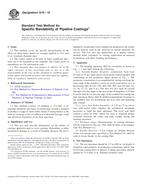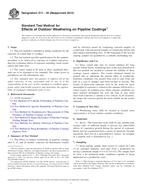We need your consent to use the individual data so that you can see information about your interests, among other things. Click "OK" to give your consent.
ASTM D4141/D4141M-14
Standard Practice for Conducting Black Box and Solar Concentrating Exposures of Coatings
STANDARD published on 1.2.2014
The information about the standard:
Designation standards: ASTM D4141/D4141M-14
Note: WITHDRAWN
Publication date standards: 1.2.2014
SKU: NS-26202
The number of pages: 6
Approximate weight : 18 g (0.04 lbs)
Country: American technical standard
Category: Technical standards ASTM
The category - similar standards:
Annotation of standard text ASTM D4141/D4141M-14 :
Keywords:
exterior exposure tests, outdoor exposure, ultraviolet/light/radiation, weathering, weather resistance, ICS Number Code 87.040 (Paints and varnishes)
Additional information
| Significance and Use | ||||||||||||||||||||||||||||||||
|
5.1 As with any accelerated test, the increase in rate of weathering compared to in service exposure is material dependent. Therefore, no single acceleration factor can be used to relate two different types of outdoor weathering exposures. The weather resistance rankings of coatings provided by these two procedures may not agree when coatings differing in composition are compared. These two procedures should not be used interchangeably. 5.2 The procedures described in this practice are designed to provide greater degradation rates of coatings than those provided by fixed angle open-rack outdoor exposure racks. For many products, fixed angle exposures will produce higher degradation rates than the normal end use of the material. 5.2.1 The use of Procedure A (Black Box) instead of an open-rack direct exposure is a more realistic test for materials with higher temperature end use service conditions. For many coatings, this procedure provides greater rates of degradation than those provided by 5°, equator-facing, open-rack exposures because the black box produces higher specimen temperatures during irradiation by daylight and longer time of wetness. The black box specimen temperatures are comparable to those encountered on the hoods, roofs, and deck lids of automobiles parked in sunlight. The relative rates of gloss loss and color change produced in some automotive coatings by exposures in accordance with Procedure A are given in ASTM STP 781.4 5.2.2 The acceleration of Procedure C is produced by reflecting sunlight from ten mirrors onto an air-cooled specimen area. In the ultraviolet portion of the solar spectrum, approximately 1400 MJ/m2 of ultraviolet radiant exposure (295 to 385 nm) is received over a typical one-year period when these devices are operated in a central Arizona climate. This compares with approximately 333 MJ/m2 of ultraviolet radiant exposure from a central Arizona at-latitude exposure and 280 MJ/m2 of ultraviolet radiant exposure from a southern Florida at-latitude exposure over the same time period. However, the test described by Procedure C reflects only direct beam radiation onto test specimens. The reflected direct beam of sunlight contains a lower percentage of short wavelength ultraviolet radiation than global daylight because short wavelength ultraviolet is more easily scattered by the atmosphere, and because mirrors are typically less efficient at shorter ultraviolet wavelengths. Ultraviolet radiant exposure levels should not be used to compute acceleration factors since acceleration is material dependent. 5.3 The weather resistance of coatings in outdoor use can be very different depending on the geographic location of the exposure because of differences in ultraviolet (UV) radiation, time of wetness, temperature, pollutants, and other factors. Therefore, it cannot be assumed that results from one exposure in a single location will be useful for determining relative weather resistance in a different location. Exposures in several locations with different climates that represent a broad range of anticipated service conditions are recommended. 5.4 Because of year-to-year climatological variations, results from a single exposure test cannot be used to predict the absolute rate at which a material degrades. 5.4.1 The degradation profile for
many polymers is not a linear function of exposure time or radiant
exposure. When short exposures are used as indications of weather
resistance, the results obtained may not be representative of those
from longer exposures.
5.5 It is recommended that at least
one control material be part of any exposure evaluation. Control
materials are used for comparing the performance of the test
materials relative to the controls when materials are not being
ranked against one another. The control material used should be of
similar composition and construction to the test materials and be
of known weather resistance. It is preferable to use two control
materials, one with relatively good weather resistance and one with
poor weather resistance.
|
||||||||||||||||||||||||||||||||
| 1. Scope | ||||||||||||||||||||||||||||||||
|
1.1 This practice covers two accelerated outdoor exposure procedures for evaluating the exterior weather resistance of coatings applied to substrates. 1.2 The two procedures are as follows: 1.2.1 Procedure A—Black Box Exposure. 1.2.2 Procedure C—Fresnel Reflector Rack Exposure. 1.3 This standard does not cover all
the procedures that are available to the user for accelerating the
outdoor exposure of coatings. Other procedures have been used in
order to provide a particular effect; however, the two procedures
described here are widely used.
1.4 The values stated in either SI units or inch-pound units are to be regarded separately as standard. The values stated in each system may not be exact equivalents; therefore, each system shall be used independently of the other. Combining values from the two systems may result in non-conformance with the standard. 1.5 This standard does not purport to address all of the safety concerns, if any, associated with its use. It is the responsibility of the user of this standard to establish appropriate safety and health practices and determine the applicability of regulatory limitations prior to use. |
||||||||||||||||||||||||||||||||
| 2. Referenced Documents | ||||||||||||||||||||||||||||||||
|
Similar standards:
Historical
1.9.2013
Historical
1.1.2014
Historical
1.11.2011
Historical
1.7.2010
Historical
1.12.2010
Historical
1.11.2012
We recommend:
Technical standards updating
Do you want to make sure you use only the valid technical standards?
We can offer you a solution which will provide you a monthly overview concerning the updating of standards which you use.
Would you like to know more? Look at this page.



 ASTM E2937-13
ASTM E2937-13 ASTM F1130-99(2014)..
ASTM F1130-99(2014).. ASTM F1428-92(2011)..
ASTM F1428-92(2011).. ASTM F2853-10e1
ASTM F2853-10e1 ASTM G10-10
ASTM G10-10 ASTM G11-04(2012)..
ASTM G11-04(2012)..
 Cookies
Cookies
